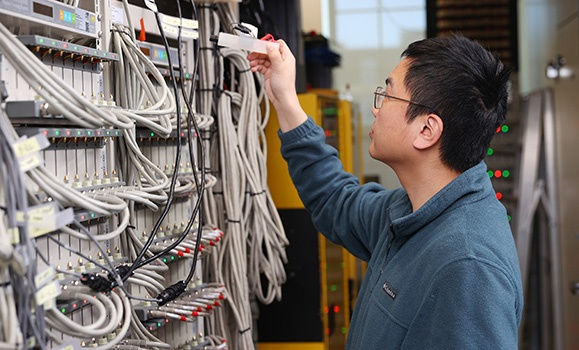Powering up: First‑in‑Canada battery innovation centre to provide critically needed facility for research and industrial development
- ckent124
- Aug 9, 2024
- 4 min read
From Dal News

Battery science is about to get a turbocharge with the creation of the country’s first university-based battery prototyping and testing facility. Called the Canadian Battery Innovation Centre, the new leading-edge lab is projected to open in Fall 2025 in Dalhousie’s Sir James Dunn Building.
The facility will be a game-changer for the university’s battery researchers, allowing them to rapidly envision, produce and test new batteries. It will also be a magnet for industry in urgent need of the sophisticated equipment and the expertise to operate it.
Battery researchers champion innovation lab
Currently, battery scientists in academia and startups are required to send designs for new batteries they want to study to third parties outside Canada for manufacture.
Drs. Michael Metzger and Chongyin Yang, the Dalhousie battery researchers championing the innovation centre, say it will vastly accelerate the speed of experimentation and innovation — turning a process that currently takes months into days.
Construction has yet to start on the $20-million facility, but with a $5-milliion grant from the Canada Foundation for Innovation, $350,000 from Emera Inc., $200,000 from Tesla, and additional matching and promised funds, the financial power is in place to jolt the project into gear.
Accelerating innovation
“We will be able to produce 50 to 100 battery cell prototypes a week at the centre,” says Dr. Metzger, Dalhousie’s Herzberg-Dahn Chair in Advanced Battery Research. “Our focus is on high quality and flexibility, so that we can test many different battery chemistries and materials combinations.” - Dr. Michael Metzger, Dalhousie’s Herzberg-Dahn Chair in Advanced Battery Research.

A series of state-of-the-art machines in an ultra-low humidity “dry room” will provide an assembly line for researchers to create battery cells to the highest industrial standards.
Comprised of different functional zones, the lab will include large mixers and furnaces to make battery materials, a smaller closed-off room for the dirtier operations like mixing powders, and a main battery assembly room that includes large coating machines where mixtures of battery active materials and other solvents get applied on metal foil that is then rolled up, inserted, filled and sealed into cell casings by a final group of machines.
Research to create batteries with range of materials
The centre’s production line will allow researchers to create batteries using a wide range of materials, including the lithium used in conventional rechargeable batteries, as well as sodium, potassium and other more abundant materials that promise to decrease battery cost and increase lifetime, efficiency and sustainability.
Dr. Metzger says the researchers will also focus on the development of new methods of production to remove toxic solvents and polymer binders that are in the process of being banned or shelved by the industry.
“This battery innovation centre will put an extremely powerful tool into the hands of our world-renowned battery scientists and bring them together with industry so that innovations can be put into action quickly. We’re catalyzing a cluster for battery research and development in Nova Scotia that promises to be transformative for the science, sector, and regional economy.” - Dr. Alice Aiken, Dalhousie’s vice-president, research and innovation.
An open approach
The only similar battery research facilities in Canada are held by corporations focused on developing proprietary intellectual property. Dalhousie’s battery testing and production line will be the first to provide open access.
For a relatively small fee used to maintain and operate the facility, the innovation centre will be available to researchers across Canada and around the world.
It will also be a magnet for businesses large and small, who the researchers predict will be attracted to Dalhousie and Nova Scotia as a hub for battery research and development.
It's a safe bet, given that an equivalent centre at the University of Michigan — one of just two in the United States — operates around the clock, with industry partners squeezing in time whenever possible. “Basically, they put up a new schedule for the next quarter on their website and the next day it’s fully booked” says Dr. Metzger.
Dan Muldoon, executive vice-president, project development and operations support at Emera Inc. says the new facility will be a benefit for its own work in exploring new energy solutions with Dalhousie’s researchers.
“The CBIC will enable groundbreaking battery research to help accelerate the clean energy transition — right here in Nova Scotia. Emera’s contribution will help leading researchers like Drs. Metzger and Yang to further the overall growth of the industry and in turn, will help advance our own efforts in energy storage innovation,” Dan Muldoon, Emera
A critical link in the supply chain
Ravi Kempaiah, CEO of Dartmouth-based battery startup Zen Energy, says companies like his will be keen to leverage the centre as well.
The former Dalhousie postdoctoral fellow who came to Nova Scotia to study with renowned battery scientist Dr. Jeff Dahn says it will allow him to expand his capacity to meet the needs of his company’s investors, like Nigerian utility North South Power, which is working with Zen to help consumers transition away from fossil fuels in emerging markets of Africa.


